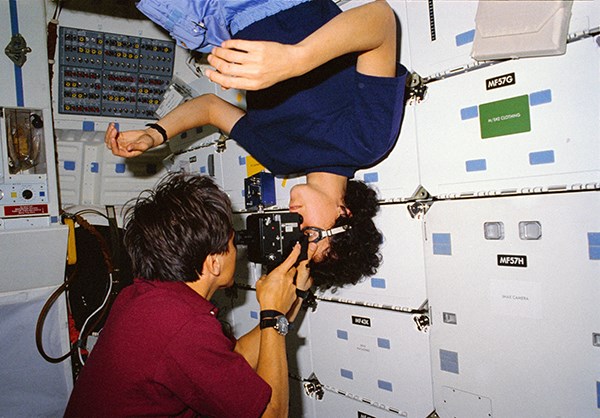These doctors not only often work clinically, such as in the ED, they also help to support the future of space travel through research and operations.
Have you ever wondered what kind of doctor supports the United States space program? Who monitors the health and wellbeing of astronauts on the International Space Station and stands at the ready for their launch and return? Who helps to plan the upcoming Lunar and Mars missions alongside engineers, pilots, and other brilliant scientists? This is the field of Aerospace Medicine.
With the White House asking Congress for an additional $1 billion for an accelerated lunar program,1 this is definitely an exciting time to be involved with the field of Aerospace Medicine. Also, with the birth of the commercial space flight industry, there is an even greater need for highly trained Aerospace Medicine physicians. However, this subspecialty is not just about space medicine; these physicians also care for the health of pilots and flight crewmembers. Many also study the physiology of microgravity on the human body and how it can help to fight conditions here on Earth (for example, the NASA Twins Study with Scott and Mark Kelly2 and the evaluation of increased intraocular pressure in space assessed by an ultrasound located on the International Space Station).
The Aerospace Medicine specialty members are like a close family, with yearly scientific meetings hosted by its largest organization, the Aerospace Medical Association (AsMA). There is even a section for students and residents: Aerospace Medicine Student and Resident Organization, with scholarships and mentoring events.
Origins
This specialty has been around for many years, and the term “space medicine” was first used in the late 1940s during the Mercury and Gemini missions.3 Currently, there are 4 accredited U.S. residency/fellowship programs for Aerospace Medicine:
● U.S. Air Force Residency in Aerospace Medicine at Wright-Patterson Air Force Base in Dayton, Ohio
● U.S. Army/Navy Residency in Aerospace Medicine in Pensacola, Florida
● University of Texas-Medical Branch in Galveston, Texas
● Mayo Clinic in Rochester, Minnesota
Participants also often receive a Master of Public Health (MPH) degree with board certification. Aerospace Medicine fellows can hail from any specialty, but according to current recommendations from one of the civilian programs, fellows must be a U.S. citizen with an MD or DO degree with clinical residencies (typically in Internal Medicine, Family Medicine, or Emergency Medicine)—although other residencies can be considered on a case-to-case basis.
Why should this interest me?
These doctors not only often work clinically, such as in the ED, they also help to support the future of space travel through research and operations. Additionally, they are crucial to the aviation industry, both commercial and military.
Because Aerospace Medicine is a subspecialty of Preventive Medicine, the field works to avoid disease/emergencies. This is not always a familiar concept to emergency physicians. Yet it can be an invaluable skill to learn how to prevent bounce-back patients to the ED. In fact, Aerospace Medicine physicians often decide fitness for duty, while traveling and working in austere environments to prevent accidents and keep the pilot (or astronaut) as fit as possible for the mission. In the same way, Aerospace Medicine physicians do mishap investigations and toxin exposure analysis if an emergency does occur. Additionally, they work with engineers to create an efficient system for launches and descent. They also focus on performance maximization through optimal sleep scheduling, task assignment and delegation, wellness activities, and functional downtime to make use of crew time in the most efficient manner possible. This is definitely applicable to the shift work in the ED.
Aerospace Medicine works with other fields to prevent emergencies through disaster preparation, specific crew training, and kit design. For example, it is often a topic of discussion regarding what medications should fly in the International Space Station, given the time and expense of taking them there, let alone discussing what medications should be considered for a lunar or Mars mission.
Therefore, given these connections to the ED and the need for Aerospace Medicine physicians in the future, this is definitely an interesting specialty to look into after graduating from an EM residency.
Where can I go for more information?
—Join the new ACEP Aerospace Medicine Section! (First meeting is at ACEP19: Monday, Oct. 28, 10 -11:30 am, Denver Convention Center Room 604)
—Visit http://www.asma.org/home
—Do a clerkship with NASA (even if you’re an attending)! https://www.nasa.gov/feature/aerospace-medicine-clerkship
References
1. Davenport C. Trump wants an additional $1.6 billion for NASA’s audacious moon mission. The Washington Post. May 13, 2019.
2. vonDeak A, Abadie L (NASA Human Research Strategic Communications). FAQs – NASA Twins Study. April 2019.
3. Lesko J. Aerospace Medicine Fellowship. In: Shafer K, ed. EMRA Fellowship Guide. 2nd ed. Dallas, TX: Emergency Medicine Residents’ Association. 2018;13-18.



